


Introduction:
What makes cooking perfect soft boiled egg so difficult is that unlike all other forms of cooking eggs, the shells still surround the egg making any determination of its doneness impossible. The only recourse is to use the culinary equivalent of dead reckoning to guess when they are done. Unhappily, the results almost always fall short of perfection. Until now.
This page not only explains how to consistently cook the perfect soft boiled egg, but to do so with such precision that you'll be able to make adjustments to satisfy exactly what your idea of how well done the ideal soft boiled egg should be.
To understand how and why this technique works, it's necessary to see what's wrong with all the other methods.
The
typical soft boiled egg recipe calls for placing eggs in simmering
water for four to five minutes. We've all followed recipes like this
only to discover, when we cracked the top off the eggs, that the
white was still watery or the yolk had been reduced to a dry marble.
Some recipes call for using lots of water, some a scant half inch.
Others call for refrigerated eggs while many demand the eggs be room
temperature. In the end they all fail to provide a consistent level
of doneness. The reason is that none of them address four variables
that have an enormous impact on how thoroughly the egg gets cooked.
In the five short minutes it'll take you to read this page, you'll
not only understand them but be able to master these variables to
create the best soft boiled eggs ever.
1.
The first variable is the most obvious, yet not one of the dozens of
recipes and YouTube videos I researched for this page addressed it: All
eggs are not the same.
Eggs vary from 55 grams for the smallest large egg to over 80 grams for the largest jumbo egg. A recipe that works perfectly for a 62 gram egg will result in an over done egg that weighs 55 grams and a grossly under done 80 gram egg. The how-to section of this page provides a scale of baking times based on egg weight. While this is a key element in making perfect soft boiled eggs it's not the only trick you'll need.
2.
The second variable that needs taming is cooking temperature.
Ignoring the small variations in the boiling temperature of water
with elevation, most people assume that boiling water is... well...
boiling water. Sadly it isn't that simple. When eggs go into boiling
water, they cool it down to below the boiling point. The water drops
from a boil to a low simmer and may even stop bubbling altogether. In
time, the heating element drives enough energy into the water to
bring it back to a boil. The problem is the in time part
of that sentence. How long it takes depends on how high the burner
is set, its maximum heat output, how much water is in the pan, the
shape, size and weight of the pan itself and how many and what size
eggs were added. While the physics of heat transfer grinds away at
all these variables to eventually get the water back to a simmer, the
eggs are still cooking. Because everyone's stove, pans, amount of
water and number of eggs vary it's impossible for any one recipe to
account for them all. The solution to this problem is simple: The
key to making perfect soft boiled eggs is not to boil them.
3.
The next variable is the most difficult to nail down. Just as all
eggs are not the same, neither are people. Some like soft boiled eggs
with runny whites. Others prefer the yolk cooked almost to a
gelatinous state. The resolution of this issue is not a technique to
be learned, but rather your making a decision: What
is your concept of the perfect soft boiled egg?
4.
Finally, eggs that come out of the pan have enough heat stored in
them that they continue to cook for up to ten minutes. Because yolks
cook very quickly and at low temperatures, an egg that's perfect one
minute after it's removed will be over done four minutes later. The
techniques presented on this page shows how to adjust for this affect
so the egg will be in perfect eating condition whether it's to be
eaten right away or ten minutes later. The only requisite is for you
to decide: When
will the egg be eaten?
Now
that the problems have been identified it's time to see how we're
going to overcome them.
The key to cooking the perfect soft boiled egg is to control the cooking temperature. Until this issue is resolved it's impossible to reliably and consistently soft boil eggs to the same level of doneness. The problem is that it is impossible to predict the cooking temperature of simmering water as it's cooled then reheated following the addition of the eggs. So we don't boil the eggs. We steam them.
Start by placing 1/2 to 3/4 inch of water in a large, deep large pan. Purchase as many metal or ceramic napkin rings as the number of soft boiled eggs needed to be cooked at one time and place them on the bottom of the pan. Space them evenly apart.
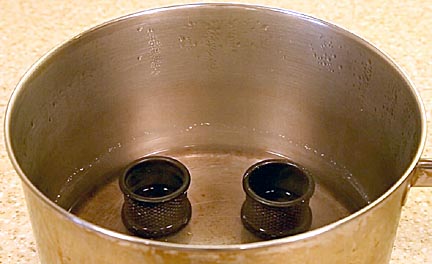
Select rings that are as long and small in diameter as possible. Cover the pan and bring the water to a boil.
Next, sort your eggs by weight.
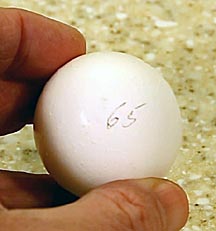
This extra large egg weighed 65 grams.
You want all the eggs to be cooked at one time to weigh within one gram of each other. Large eggs range from 55 to 65 grams, extra large from 58 to 67 grams and jumbos from 60 to 75 grams, though I've found some that top 80. (These are actual weights I've measured myself.) I never use medium eggs because they are so small it's difficult to get a spoon into them without breaking the shell. Also, avoid using cracked eggs because they tend to flow out of the crack as they cook.
Keep the eggs in a refrigerator until the last possible moment. Egg yolks cook much faster than whites. Keeping them cold slows how fast the yolks, which are in the center of the eggs, cook.
Once the water is boiling, place an egg upright on each napkin ring and quickly cover the pan.
Because the eggs never touch the water, it never stops boiling and the cooking temperature remains constant. This simple step eliminates all the problems associated with the temperature of the cooking water changing depending on how many eggs are added. I've found the cooking times are the same whether I'm steaming one egg or four.
The following chart provides the steaming time for eggs based on my preference, which is the white thoroughly cooked followed by a very thin layer of barely set yolk with the rest of the yolk thick and creamy:
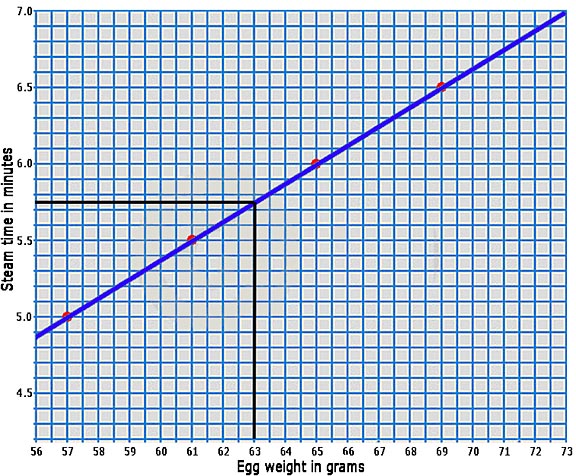
For example: Suppose you had an egg that weighed 63 grams. Starting at the 63 gram position on the bottom axis, draw a line up to where it intersects the blue diagonal line. From that point draw a line to the left until it hits the vertical axis, where it indicates a steaming time of 5.75 minutes or 5 minutes 45 seconds. Set your timer for this period, uncover the boiling pot with the napkin ring in it, place the egg on the ring...
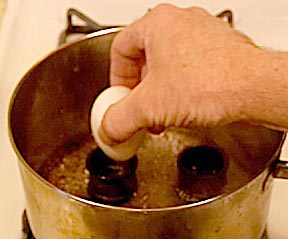
...cover the pot and start the timer. After 5 minutes, 45 seconds, use tongs to remove the egg and place it in an egg holder.
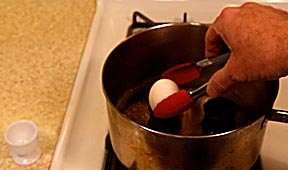
Let the egg cool in air for two minutes before eating. I choose two minutes as the resting period because it's close to the amount of time it typically takes to finish a breakfast plate, get it to the table, sit down and start eating. This two minute cooling time needs to be observed for perfect doneness. If eaten immediately after the egg comes out of the pan, not only will it be too hot to handle but the internal heat will not have had the time needed to finish cooking the white.
If the egg isn't going to be eaten for five to ten minutes, reduce the steaming time by half a minute to prevent the eggs over cooking from their own heat.
If you prefer softer whites, subtract half a minute from the cooking time. For a thicker layer of set yolk, add half a minute. Because the cooking temperature is constant and the relationship between egg size and doneness is known, it's easy to adjust cooking times to fine tune your concept for the perfect soft boiled egg.
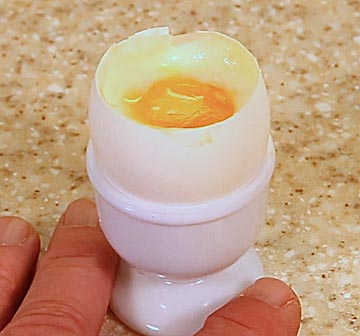
Add a small pinch of salt and dig it!
The following video shows the entire process in action:
Return to my main page to browse 97 other subjects